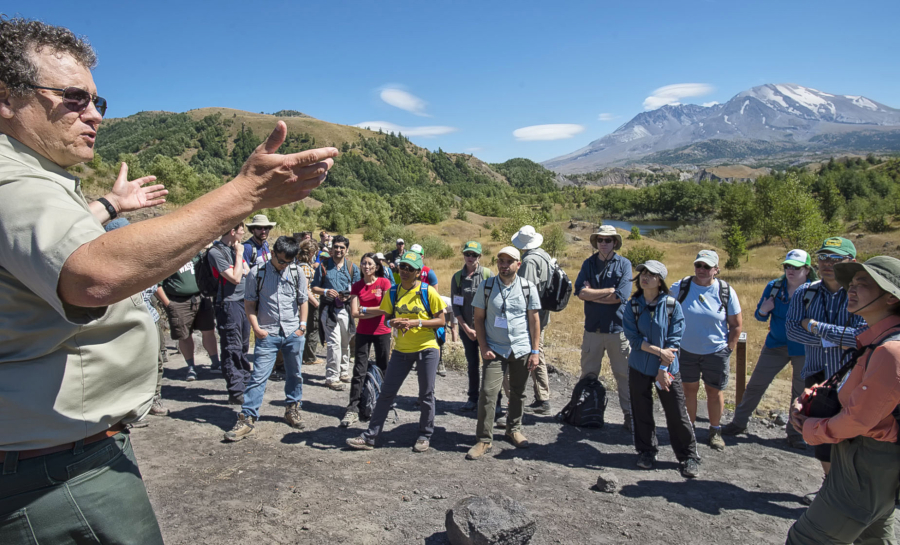LONGVIEW — Normally, when more than a thousand scientists flock to a volcano, something horrible has just happened. But the hordes of researchers who swarmed to Mount St. Helens on Wednesday were just there to draw lessons from one of the world’s most famous volcanoes.
About 1,100 scientists from around the world rode charter buses from Portland to different sites at Mount St. Helens to see the volcano for themselves. Some of them said they owed their careers to the volcano.
Volcanologists were gathered in Portland for the assembly of the International Association of Volcanology or Chemistry of the Earth’s Interior. Wednesday was the “field trip day,” and some of the scientists chose to visit Mount Hood or the Columbia River Gorge instead of Mount St. Helens.
One of the visitors to Johnston Ridge and the Hummocks Trail on Wednesday was Roberto Sulpizio, a professor of earth and geo-environmental sciences at the University of Bari in southern Italy, as well as the IAVCEI’s secretary general.
Sulpizio, who was visiting Mount St. Helens for only his second time, said information he learned could help Italian scientists track their own explosive volcanoes.
“We have a lot of potential explosive volcanoes in Italy, like Vesuvius for example,” he said, speaking of the volcano that destroyed the Roman city of Pompeii in 79 A.D. “It’s very useful for us to see this and try to carry (information) home.”
Rosa Didonna, another Italian scientist on Wednesday’s tour, said the size and scope of the volcano must be seen in person to be understood and appreciated.
“It’s huge,” she said. “You can read lots of papers. You can watch many videos on YouTube and pictures, photos, but it’s different when you’re here.”
For some scientists on the field trip, seeing Mount St. Helens was especially poignant because the deadly eruption on May 18, 1980, sparked their interest in volcanology.
“Growing up, my parents always talked about (Mount St. Helens), so I got interested in volcanoes,” said Ashleigh Reeves, a 25-year-old graduate student at East Tennessee State University. ” ‘You have to see Mount St. Helens,’ they said. Being in this area, with some of the best volcanologists in the world, what better place to come to?”
Didonna had a similar experience as Reeves, being drawn to study volcanoes after the 1980 eruption.
“When I started to read something about volcanoes, (Mount St. Helens) was my first volcano, first eruption,” she said. “That’s why it was amazing for me to be here today, and I think this conference is amazing.”
David Pyle, a professor of volcanology at the University of Oxford, said he was 15 when Mount St. Helens erupted in 1980, and has been fascinated by volcanoes ever since. Now, he said his goal is to spark that curiosity in his students who weren’t alive at the time.
“Even though Mount St. Helens’ eruption was nearly 40 years ago, and for our 18-year-old students that’s deep in history, they’ve all heard of Mount St. Helens nonetheless,” said Pyle, 52. “It’s in storybooks, it’s in books they read at school. Having been there makes it much easier to bring it to life in the classroom.”
Of course, there are no volcanoes in England.
“In the U.K., we’re very fortunate because we can learn about volcanoes and earthquakes, which are things that happen elsewhere,” he said. “It’s a positive choice to study them. We’re not mandated for a particular reason, it’s mostly for the interest.”
Thomas Casadevall, 70, studied Mount St. Helens with the U.S. Geological Survey for much of the 1980s, including before and immediately after the 1980 blast. He acted as a tour guide for the buses of scientists Wednesday.
Casadevall agreed with Pyle that teaching younger researchers about the complexities of Mount St. Helens is important.
“I think it is important to have a generational transfer of knowledge between the different generations,” Casadevall said. “I was working here 37 years ago, and on the field trip, I’m with two very young guys who just started working here, so they weren’t even born in 1980. For them to hear about what happened in 1980 is a valuable lesson, and I certainly enjoy talking about it.”
Casadevall said the 1,100 IAVECI visitors were divided into groups and saw multiple parts of the volcano, from the Johnston Ridge Observatory to Coldwater Lake.
Peter Frenzen, chief scientist for the Mount St. Helens National Monument, was helping guide visitors Wednesday as well, and said he attended IAVCEI meetings at their conference in Portland. He said the day-long field trip was a brilliant idea.
“I think IAVCEI is doing a really smart thing by having a mid-conference field trip, because after two days of all-day meetings, you’re ready for a break,” Frenzen said. “This is a great way to take a break.”
Of course, one of the main reasons some scientists mentioned they were interested in Mount St. Helens is to figure out how to mitigate the effects of a deadly volcanic explosion elsewhere. Reeves said that’s one of the reasons why she studies volcanoes.
“Every volcano is separate, and you never know what could happen, but that just means our jobs are that much more important,” she said. “We need to try to prevent this things from happening.”



